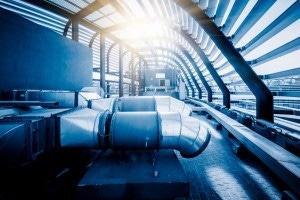Down The Drain? HVAC Systems Suffer Stubborn Water Woes
 Water is a constant for HVAC systems. In winter, heating systems produce water as air condenses in the cold, while in summer the need for quick cooling of large air volumes produces a significant amount of moisture build-up. Despite this ongoing relationship with condensed and collected water, however, a recent ACHR News article notes that most HVAC systems aren’t up to the challenge of proper drainage—putting both system efficiency and human health at risk.
Water is a constant for HVAC systems. In winter, heating systems produce water as air condenses in the cold, while in summer the need for quick cooling of large air volumes produces a significant amount of moisture build-up. Despite this ongoing relationship with condensed and collected water, however, a recent ACHR News article notes that most HVAC systems aren’t up to the challenge of proper drainage—putting both system efficiency and human health at risk.
It’s a Trap!
According to ACHR, the current industry-standard for HVAC drains isn’t enough to ensure water exits the system in a timely fashion. Why? Because the condensate trap model exists as a crossover between the HVAC unit and the building’s plumbing supply, meaning it’s hard to identify who’s responsible for maintenance. HVAC techs rightly claim they’re not plumbing experts and can only ensure proper airflow and system performance, while plumbing pros are understandably reticent to tear open HVAC panels and start poking around.
Without a lab-tested and approved drain model specific to HVAC units, the industry relies on existing plumbing codes and installs what should be a reasonable way to vacate water. But in most cases these drain systems are under negative (below ambient) pressure, meaning they tend to hold rather than release water. The result? The best-case scenario is damage to the condenser unit that can be repaired with a costly maintenance call-out. The worst-case is that water spills over into ceiling tiles or has bacterial spores picked up and circulated again through office buildings.
Too Tight
As noted by Daily Commercial News there’s another facet to this problem: Tight buildings. In contrast to the drafty buildings raised three decades ago, today’s homes are virtually air and water-tight. Homeowners and building managers are often advised to keep furnace fans running at all times to encourage the movement of air and displace moisture. HVAC systems with poor drainage pose a serious problem for these new, tight buildings. Their moisture isn’t being properly moved thanks to frozen, shallow, or blocked drains. Instead, it’s picked up and carried throughout the living or working space again and again, each time picking up more contaminants and increasing the risk of “sick building” development.
So what’s the answer? It starts with effective preventive maintenance. It’s critical to manage the kind of negative biological growth linked to stagnant water using a mold-and-mildew inhibitor, especially if drains can’t immediately be fixed or replaced. Home and business owners can also specify certain drain conditions—for example no moving parts or the need for priming—but in the long term solving this problem will require time, energy, and investment from the energy industry.
While this effort has been slow in coming thanks to the lucrative nature of service calls, both owners and HVAC contractors now see the value in more advanced, predictive maintenance solutions which should in turn drive the development of new, much-improved drainage solutions.
Next Steps:
- Subscribe to our blog to stay informed about the latest HVAC news and insight.
- Stay up to date on facility maintenance tools such as chiller tube cleaners, boiler tube cleaners, hose/pipe cleaners, descaler systems, industrial vacuums, commercial pressure washers, and drain cleaners.


Heat Pumps Auckland
Thanks for the article guys. Really enjoying the frequent blog posts you are putting out. Keep up the great work.